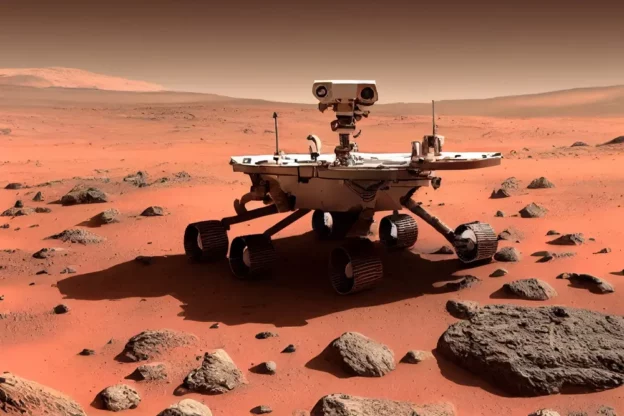Marking its thousandth day on Mars, NASA’s Perseverance rover recently concluded its exploration of the ancient river delta that harbors evidence of a lake that occupied Jezero Crater billions of years ago. So far, this scientific vehicle has collected a total of 23 samples , simultaneously revealing the geological history of this Martian area.
One of the samples, called “Lefroy Bay,” contains a significant amount of fine-grained silica, a material recognized for preserving ancient fossils on Earth. The other, called “Otis Peak”, presents an appreciable amount of phosphate, frequently associated with the presence of life as we know it. Both samples also contain abundant carbonate, which could preserve a record of environmental conditions since the rock formed.
The discoveries were shared last December at the American Geophysical Union’s fall meeting in San Francisco.
“We chose Jezero Crater as the landing site because orbital images showed a delta, clear evidence that a large lake once filled the crater. A lake is a potentially habitable environment, and delta rocks are an excellent environment for burying signs of ancient life as fossils in the geological record.”said Perseverance project scientist Ken Farley of Caltech. ” After exhaustive exploration, we have reconstructed the geological history of the crater, charting its lake and river phase from beginning to end .”
Billions of years ago, water entered Jezero Crater, forming a lake, a delta and rivers before Mars dried up. The genesis of Jezero dates back almost 4 billion years, when it was formed from the impact of an asteroid.
Since Perseverance ‘s landing in February 2021, the team has discovered that the crater floor is composed of igneous rock generated from underground magma or volcanic activity on the surface. Later, layers of sandstone and shale were found, marking the arrival of the first river to the crater hundreds of millions of years later. Above these layers, salt-rich shales were identified, indicating the presence of a shallow lake that underwent evaporation processes.
It is estimated that this lake grew over time until reaching dimensions of 35 km in diameter and 30 meters deep.
In later stages, rapid water flow transported rocks from outside Jezero, distributing them over the top of the delta and other areas of the crater.
” We were able to see a broad summary of these chapters in Jezero’s history in orbital images, but it was necessary to get closer to Perseverance to really understand the timeline in detail ,” said Libby Ives, a postdoctoral fellow at the Jet Propulsion Laboratory. POT. in Southern California, which manages the mission.
Samples from NASA’s Perseverance rover
Samples collected by Perseverance are stored in dedicated metal tubes as part of the Mars Sample Return initiative, a collaboration between NASA and the European Space Agency (ESA). Moving these tubes to Earth would make it possible for scientists to study the samples using high-capacity laboratory equipment, which is too bulky to take to Mars.
In the process of selecting the samples to collect, Perseverance uses an abrasion tool to abrade a portion of a possible rock and subsequently analyzes the chemistry of the rock using high-precision scientific instruments, including the Planetary Lithochemistry Instrument. X-ray (PIXL), developed by JPL.
During an evaluation at a site called “Bills Bay”, PIXL identified the presence of carbonates, minerals that form in aqueous environments with conditions conducive to the preservation of organic molecules (produced by geological and biological processes). These rocks also contained a significant amount of silica, a highly effective material for preserving organic molecules, including those related to life.
“On Earth, this fine-grained silica is what is often found in a place that was once sandy.“said JPL’s Morgan Cable, deputy principal investigator for PIXL.”It is the type of environment where, on Earth, remains of ancient life could be preserved and found later“.
Perseverance’s instruments have the ability to identify microscopic structures that resemble fossils and chemical changes that could have been caused by ancient microorganisms, although no conclusive evidence of either of these elements has been found so far.
At another site examined by PIXL, called “Ouzel Falls,” the instrument detected the presence of iron associated with phosphate. Phosphate is an essential component of DNA and cell membranes present in all known life on Earth, and is part of a molecule crucial for energy transport within cells.
After analyzing PIXL’s discoveries in each of these weathered areas, the team sent commands to the rover to collect nearby rock cores: Lefroy Bay was collected next to Bills Bay and Otis Peak in Ouzel Falls.
” We have ideal conditions to find signs of ancient life where we find carbonates and phosphates, which point to a watery and habitable environment, as well as silica, which is excellent for conservation ,” Cable said.
Of course, Perseverance’s work is far from complete. The mission’s current fourth science campaign will focus on exploring the rim of Jezero Crater, especially near the canyon entrance where a river once filled the crater bed.
Don’t miss any of our posts and follow us on social media!
Inspenet.com YouTube LinkedIn Facebook Instagram
Source: mars.nasa.gov


